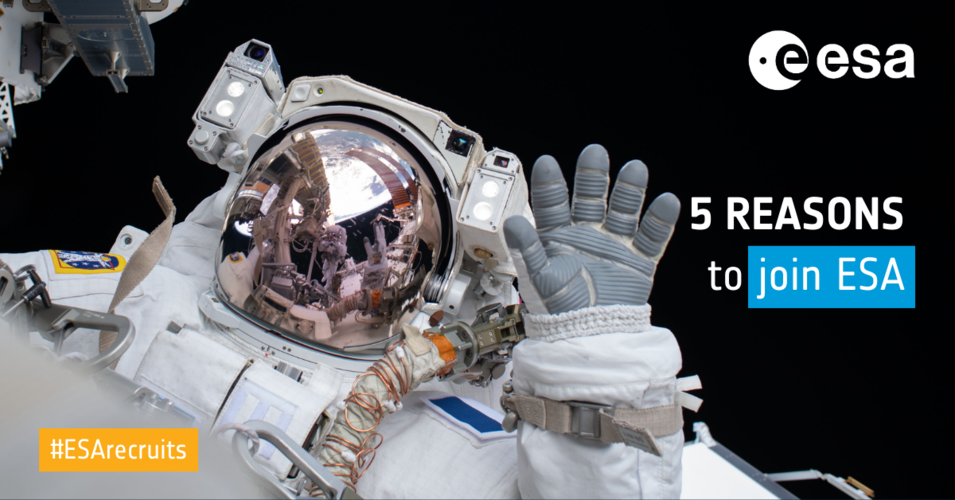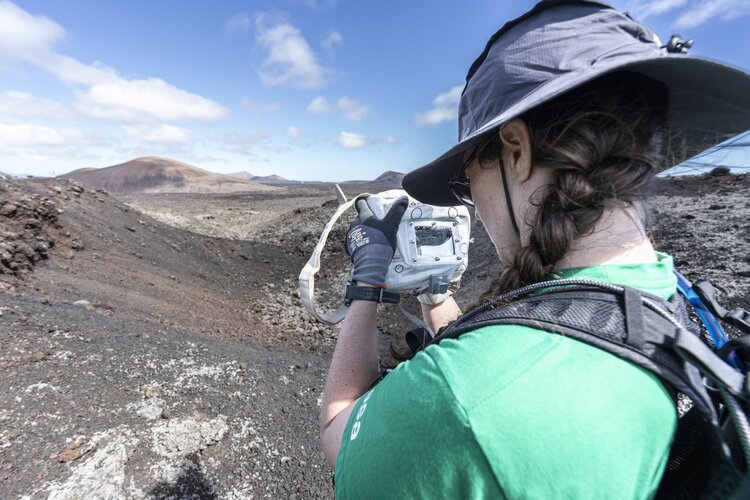Sentinel-1C arrives in French Guiana
Wednesday, 09 October 2024 07:40
The Sentinel-1C satellite, the third satellite of the Copernicus Sentinel-1 mission, has arrived at the European spaceport in French Guiana for liftoff on the Vega-C rocket at the end of 2024. The satellite will continue the critical task of delivering key radar imagery of Earth’s surface for a wide range of Copernicus services and scientific applications.
Five reasons to join the European Space Agency!
Wednesday, 09 October 2024 07:31
In 2023, ESA published more than 400 vacancies in engineering, science and business and administration and more positions continue to be published as we are always on the lookout for talented new colleagues to join us. So, what does it mean to join ESA? Here are five reasons why you should consider ESA as the next step in your career!
European settings for a Moon camera
Wednesday, 09 October 2024 07:24 Image:
European settings for a Moon camera
Image:
European settings for a Moon camera NASA awards Rocket Lab study contract for Mars Sample Return
Tuesday, 08 October 2024 21:54

SPACEBEL plays key role in ESA's Hera mission
Tuesday, 08 October 2024 20:35 The European Space Agency's (ESA) Hera mission, named after the Greek goddess of marriage, marks Europe's first step in planetary defense. In collaboration with NASA's DART probe, Hera forms the second phase of a global initiative to test methods of asteroid deflection, aimed at protecting Earth from potential asteroid threats. The mission's target is the Didymos binary asteroid system, which co
The European Space Agency's (ESA) Hera mission, named after the Greek goddess of marriage, marks Europe's first step in planetary defense. In collaboration with NASA's DART probe, Hera forms the second phase of a global initiative to test methods of asteroid deflection, aimed at protecting Earth from potential asteroid threats. The mission's target is the Didymos binary asteroid system, which co Queen's astronomer joins first planetary defense mission
Tuesday, 08 October 2024 20:35 A Queen's University astronomer is set to play a key role in the European Space Agency's (ESA) first planetary defense mission, a project two decades in the making. Professor Alan Fitzsimmons, from the university's Astrophysics Research Centre, will join the Hera mission from the European Space Operations Centre in Germany as it prepares to study how asteroids can be deflected to prevent a poten
A Queen's University astronomer is set to play a key role in the European Space Agency's (ESA) first planetary defense mission, a project two decades in the making. Professor Alan Fitzsimmons, from the university's Astrophysics Research Centre, will join the Hera mission from the European Space Operations Centre in Germany as it prepares to study how asteroids can be deflected to prevent a poten Europe's Hera asteroid mission supported by Beyond Gravity technology
Tuesday, 08 October 2024 20:35 Beyond Gravity, a key supplier to the space industry, has provided essential components for Europe's first planetary defense mission, Hera. The company has delivered solar wings, a central structural tube, and electronic products critical to the mission's success.
The Hera mission, part of the European Space Agency's (ESA) planetary defense program, is set to launch between October 7 and 2
Beyond Gravity, a key supplier to the space industry, has provided essential components for Europe's first planetary defense mission, Hera. The company has delivered solar wings, a central structural tube, and electronic products critical to the mission's success.
The Hera mission, part of the European Space Agency's (ESA) planetary defense program, is set to launch between October 7 and 2 New study reduces concerns over asteroid swarm threat
Tuesday, 08 October 2024 20:35 Astronomers have some reassuring news regarding potentially hazardous asteroids near Earth: there are fewer than previously thought.
Using the Zwicky Transient Facility (ZTF) telescope, researchers from the University of Maryland led a study to survey the Taurid swarm, a group of space debris associated with the comet Encke. These meteor showers, visible in October and November, have long
Astronomers have some reassuring news regarding potentially hazardous asteroids near Earth: there are fewer than previously thought.
Using the Zwicky Transient Facility (ZTF) telescope, researchers from the University of Maryland led a study to survey the Taurid swarm, a group of space debris associated with the comet Encke. These meteor showers, visible in October and November, have long Comet A3: How and when to see Tsuchinshan-ATLAS
Tuesday, 08 October 2024 20:35 Stargazers will have the chance to spot what could be the most impressive comet of the year over the coming weeks.
Comet A3 (Tsuchinshan-ATLAS) has generated so much excitement about how bright and visible it might be that it has even been billed as the "comet of the century" in some quarters.
Although that is "not very likely", according to the Royal Astronomical Society's Dr Robert
Stargazers will have the chance to spot what could be the most impressive comet of the year over the coming weeks.
Comet A3 (Tsuchinshan-ATLAS) has generated so much excitement about how bright and visible it might be that it has even been billed as the "comet of the century" in some quarters.
Although that is "not very likely", according to the Royal Astronomical Society's Dr Robert Amentum wins $256M NASA contract to support space exploration
Tuesday, 08 October 2024 20:35 Amentum (NYSE: AMTM) has secured the Fully Integrated Lifecycle Mission Support Services II (FILMSS II) contract, valued at up to $256 million, to advance NASA's space exploration and aeronautics initiatives at the Ames Research Center. Through this agreement, Amentum will implement cutting-edge technologies and project management tools to strengthen NASA's capabilities in both space science and
Amentum (NYSE: AMTM) has secured the Fully Integrated Lifecycle Mission Support Services II (FILMSS II) contract, valued at up to $256 million, to advance NASA's space exploration and aeronautics initiatives at the Ames Research Center. Through this agreement, Amentum will implement cutting-edge technologies and project management tools to strengthen NASA's capabilities in both space science and Boosting SpaceForest's Perun sounding rocket development
Tuesday, 08 October 2024 20:35 SpaceForest, a Poland-based company, is advancing its efforts to develop a new European single-stage sounding rocket, designed for commercial microgravity experiments. The rocket, standing at 11.5 meters tall, will offer up to four minutes of microgravity, with a payload capacity of 50 kg and a launch altitude of up to 150 km. The system includes stabilizing features to ensure high-quality micro
SpaceForest, a Poland-based company, is advancing its efforts to develop a new European single-stage sounding rocket, designed for commercial microgravity experiments. The rocket, standing at 11.5 meters tall, will offer up to four minutes of microgravity, with a payload capacity of 50 kg and a launch altitude of up to 150 km. The system includes stabilizing features to ensure high-quality micro Dawn Aerospace demos rapid reusability with back-to-back rocket-powered flights
Tuesday, 08 October 2024 20:35 Dawn Aerospace has successfully demonstrated the same-day reusability of its rocket-powered aircraft, the Mk-II Aurora, completing two flights within an 8-hour window. Both flights, conducted from Glentanner Aerodrome in New Zealand, reached speeds of Mach 0.9, or 950 km/h, and an altitude of 63,000 feet. These missions mark the 8th and 9th rocket-powered flights of the Mk-II Aurora.
"Rapi
Dawn Aerospace has successfully demonstrated the same-day reusability of its rocket-powered aircraft, the Mk-II Aurora, completing two flights within an 8-hour window. Both flights, conducted from Glentanner Aerodrome in New Zealand, reached speeds of Mach 0.9, or 950 km/h, and an altitude of 63,000 feet. These missions mark the 8th and 9th rocket-powered flights of the Mk-II Aurora.
"Rapi Interstellar welcomes new expertise and expands rocket production capacity
Tuesday, 08 October 2024 20:35 Interstellar Technologies Inc. ("Interstellar"), a space infrastructure company focused on space transportation and utilization, has made significant strides both in talent acquisition and production expansion. With new secondees from seven organizations, including three Toyota affiliates, and the opening of a new production facility in Hokkaido, Interstellar continues to strengthen its efforts
Interstellar Technologies Inc. ("Interstellar"), a space infrastructure company focused on space transportation and utilization, has made significant strides both in talent acquisition and production expansion. With new secondees from seven organizations, including three Toyota affiliates, and the opening of a new production facility in Hokkaido, Interstellar continues to strengthen its efforts New Shepard NS-27 set for launch with second human-rated rocket
Tuesday, 08 October 2024 20:35 Blue Origin has confirmed that its New Shepard NS-27 mission is on schedule for launch on October 7, 2024. The launch window opens at 8:00 AM CDT / 1300 UTC, with live coverage starting at 7:45 AM CDT on BlueOrigin.com.
The NS-27 mission will introduce Blue Origin's second human-rated New Shepard vehicle, expanding its capacity to meet increasing customer demand. While this launch will be
Blue Origin has confirmed that its New Shepard NS-27 mission is on schedule for launch on October 7, 2024. The launch window opens at 8:00 AM CDT / 1300 UTC, with live coverage starting at 7:45 AM CDT on BlueOrigin.com.
The NS-27 mission will introduce Blue Origin's second human-rated New Shepard vehicle, expanding its capacity to meet increasing customer demand. While this launch will be PLD Space unveils plan for reusable MIURA Next launchers and LINCE manned capsule
Tuesday, 08 October 2024 20:35 PLD Space presented its strategic vision at the Beyond event, hosted at the company's new headquarters in Elche, Spain, to celebrate the first anniversary of the MIURA 1 launch. During the event, the company highlighted the significant advances in the MIURA 5 program, with a goal of launching by late 2025.
In addition to MIURA 5, PLD Space revealed two ambitious projects: MIURA Next, a new
PLD Space presented its strategic vision at the Beyond event, hosted at the company's new headquarters in Elche, Spain, to celebrate the first anniversary of the MIURA 1 launch. During the event, the company highlighted the significant advances in the MIURA 5 program, with a goal of launching by late 2025.
In addition to MIURA 5, PLD Space revealed two ambitious projects: MIURA Next, a new 
